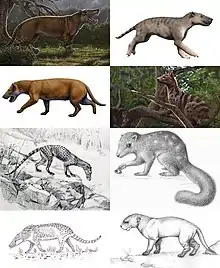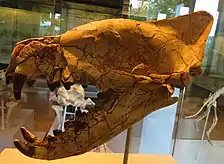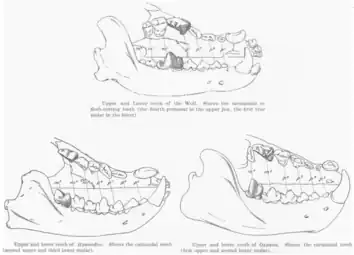Hyaenodonta
Hyaenodonta ("hyena teeth") is an extinct order of hypercarnivorous placental mammals of clade Pan-Carnivora from mirorder Ferae.[6][7] Hyaenodonts were important mammalian predators that arose during the early Paleocene in Europe[8] and persisted well into the late Miocene.[9]
| Hyaenodonta Temporal range: early Paleocene to late Miocene (Suspected Late Cretaceous origin, but unconfirmed by fossils yet)[1][2] | |
|---|---|
 | |
| Scientific classification | |
| Domain: | Eukaryota |
| Kingdom: | Animalia |
| Phylum: | Chordata |
| Class: | Mammalia |
| Mirorder: | Ferae |
| Clade: | Pan-Carnivora |
| Order: | †Hyaenodonta Van Valen, 1967[3] |
| Subgroups | |
|
[see classification] | |
| Synonyms | |
Characteristics


Hyaenodonts are characterized by long skulls, slender jaws, slim bodies and a plantigrade stance. They generally ranged in size from 30 to 140 cm at the shoulder.[10] While Simbakubwa kutokaafrika may have been up to 1,500 kg (3,300 lb) (surpassing the modern polar bear in size[11]) and Hyaenodon gigas (the largest species from genus Hyaenodon) was as much as 1.4 m high at the shoulder, 3.0 m long and weighed about 330 kg, most of hyaenodonts were in the 5–15 kg range, equivalent to a mid-sized dog.[12] The anatomy of their skulls show that they had a particularly acute sense of smell, while their teeth were adapted for shearing, rather than crushing.[10]
Because of their size range, it is probable that different species hunted in different ways, which allowed them to fill many different predatory niches. Smaller ones would hunt in packs during the night like wolves, and bigger, fiercer ones would hunt alone during the daylight, using their sheer size and their mighty jaws as their principal weapon. The carnassials in a hyaenodonts are generally the second upper and third lower molars. However, some hyaenodonts possessed as many as three sequential pairs of carnassials or carnassial-like molar teeth in their jaws.[13] Hyaenodonts, like all creodonts, lacked post-carnassial crushing molar teeth, such as those found in many carnivoran families, especially the Canidae and Ursidae, and thus lacked dental versatility for processing any foods other than meat.[13]
Hyaenodonts differed from Carnivora in that they replaced their deciduous dentition slower in development than carnivorans.[14] Studies on Hyaenodon show that juveniles took 3–4 years in the last stage of tooth eruption, implying a very long adolescent phase. In North American forms, the first upper premolar erupts before the first upper molar, while European forms show an earlier eruption of the first upper molar.[15]
At least one hyaenodont lineage, subfamily Apterodontinae, was specialised for aquatic, otter-like habits.[16]
Range
Having evolved in Europe during the Paleocene,[8] hyaenodonts soon after spread into Africa and India, implying close biogeographical connections between these areas.[16][17] Afterwards, they dispersed into Asia from either Europe or India, and finally, North America from either Europe or Asia.[18][19]
They were important hypercarnivores in Eurasia, Africa, and North America during the Oligocene, but declined towards the end of the epoch, with almost the entire order becoming extinct by the close of the Oligocene. Several representatives of this order, including hyainailourids Megistotherium, Simbakubwa, Hyainailouros, Sectisodon, Exiguodon, Sivapterodon, Metapterodon, and Isohyaenodon, the prionogalid Prionogale, the teratodontid Dissopsalis and the youngest species of genus Hyaenodon, H. weilini, survived into or evolved during the Miocene, of which, only Dissopsalis survived long enough to go extinct at the close of the Miocene.[9] Traditionally, this has been attributed to competition with carnivorans, but no formal examination of the correlation between the decline of hyaenodonts and the expansion of carnivorans has been recorded, and the latter may simply have moved into vacant niches after the extinction of hyaenodont species.[20]
Classification and phylogeny
Relations
Hyaenodonts were considerably more widespread and successful than the oxyaenids, the other clade of mammals originally classified along with the hyaenodonts as part of Creodonta.[10] In 2015 phylogenetic analysis of Paleogene mammals, by Halliday et al., monophyly of Creodonta is confirmed and it is placed in the clade Ferae, closer to Pholidota than to Carnivora.[21] However, order Creodonta is now considered to be a polyphyletic wastebasket taxon containing two unrelated clades assumed to be closely related (or ancestral) to Carnivora.[22][23][24][16][15][17][14][25][26][8][27]
Taxonomy
Order: †Hyaenodonta (Van Valen, 1967)
|
Phylogeny
The phylogenetic relationships of order Hyaenodonta are shown in the following cladograms:[17][28][14][8][27][29][30]
| Ferae |
| |||||||||||||||||||||||||||||||||||||
| †Hyaenodonta |
|
|||||||||||||||||||||||||||||||||||||||||||||||||||||||||||||||||||||||||||||||||||||||||||||||||||||||||||||||||||||||||||||||||||||||||||||||||||||||||||||||||||||||||||||||||||||||||||||||||||||||||||||||||||||||||||||||||||||||||||||||||||||||||||||||||||||||
| sensu stricto ••••••> | ||||||||||||||||||||||||||||||||||||||||||||||||||||||||||||||||||||||||||||||||||||||||||||||||||||||||||||||||||||||||||||||||||||||||||||||||||||||||||||||||||||||||||||||||||||||||||||||||||||||||||||||||||||||||||||||||||||||||||||||||||||||||||||||||||||||||
See also
References
- Matthew R. Borths; Patricia A. Holroyd; Erik R. Seiffert (2016). "Hyainailourine and teratodontine cranial material from the late Eocene of Egypt and the application of parsimony and Bayesian methods to the phylogeny and biogeography of Hyaenodonta (Placentalia, Mammalia)". PeerJ. 4: e2639. doi:10.7717/peerj.2639. PMC 5111901. PMID 27867761.
- Matthew R. Borths; Nancy J. Stevens (2017). "The first hyaenodont from the late Oligocene Nsungwe Formation of Tanzania: Paleoecological insights into the Paleogene-Neogene carnivore transition". PLOS ONE. 12 (10): e0185301. Bibcode:2017PLoSO..1285301B. doi:10.1371/journal.pone.0185301. PMC 5636082. PMID 29020030.
- L. Van Valen (1967.) "New Paleocene insectivores and insectivore classification." Bulletin of the American Museum of Natural History 135(5):217-284
- Solé F. (2010) "Les premiers placentaires carnassiers européens (Oxyaenodonta, Hyaenodontida et Carnivora): origine, évolution, paléoécologie et paléobiogéographie; apport des faunes de l'Eocène inférieur du Bassin de Paris." Paris: Muséum National d'Histoire Naturelle. 703 p.
- Morlo, M., Gunnell, G. F. and Polly, P. D. (2009.) "What, if not nothing, is a creodont? Phylogeny and classification of Hyaenodontida and other former creodonts." Journal of Vertebrate Paleontology Program and Abstracts, 2009:152A.
- Solé, F.; Lhuillier, J.; Adaci, M.; Bensalah, M.; Mahboubi, M.; Tabuce, R. (2013-07-16). "The hyaenodontidans from the Gour Lazib area (?Early Eocene, Algeria): implications concerning the systematics and the origin of the Hyainailourinae and Teratodontinae". Journal of Systematic Palaeontology. 12 (3): 303–322. doi:10.1080/14772019.2013.795196. S2CID 84475034.
- Solé, F.; Amson, E.; Borths, M.; Vidalenc, D.; Morlo, M.; Bastl, K. (2015-09-23). "A New Large Hyainailourine from the Bartonian of Europe and Its Bearings on the Evolution and Ecology of Massive Hyaenodonts (Mammalia)". PLOS ONE. 10 (9): e0135698. Bibcode:2015PLoSO..1035698S. doi:10.1371/journal.pone.0135698. PMC 4580617. PMID 26398622.
- Matthew R. Borths; Nancy J. Stevens (2019). "Simbakubwa kutokaafrika, gen. et sp. nov. (Hyainailourinae, Hyaenodonta, 'Creodonta,' Mammalia), a gigantic carnivore from the earliest Miocene of Kenya". Journal of Vertebrate Paleontology. 39 (1): e1570222. Bibcode:2019JVPal..39E0222B. doi:10.1080/02724634.2019.1570222. S2CID 145972918.
- Barry, J. C. (1988). "Dissopsalis, a middle and late Miocene proviverrine creodont (Mammalia) from Pakistan and Kenya". Journal of Vertebrate Paleontology. 48 (1): 25–45. doi:10.1080/02724634.1988.10011682.
- Lambert, David and the Diagram Group (1985): The Field Guide to Prehistoric Life. Facts on File Publications, New York. ISBN 0-8160-1125-7
- Borths, M. R.; Stevens, N. J. (2019). "Simbakubwa kutokaafrika, gen. et sp. nov. (Hyainailourinae, Hyaenodonta, 'Creodonta,' Mammalia), a gigantic carnivore from the earliest Miocene of Kenya". Journal of Vertebrate Paleontology. 39: e1570222. Bibcode:2019JVPal..39E0222B. doi:10.1080/02724634.2019.1570222. S2CID 145972918.
- Egi, Naoko (2001). "Body Mass Estimates in Extinct Mammals from Limb Bone Dimensions: the Case of North American Hyaenodontids". Palaeontology. 44 (3): 497–528. doi:10.1111/1475-4983.00189.
- Wang, Xiaoming; and Tedford, Richard H. (2008.) "Dogs: Their Fossil Relatives and Evolutionary History." New York: Columbia University Press
- Borths, Matthew R; Stevens, Nancy J (2017). "Deciduous dentition and dental eruption of Hyainailouroidea (Hyaenodonta, "Creodonta," Placentalia, Mammalia)". Palaeontologia Electronica. 20 (3): 55A. doi:10.26879/776.
- Bastl, Katharina Anna (2013). "First evidence of the tooth eruption sequence of the upper jaw in Hyaenodon (Hyaenodontidae, Mammalia) and new information on the ontogenetic development of its dentition". Paläontologische Zeitschrift. 88 (4): 481–494. doi:10.1007/s12542-013-0207-z. S2CID 85304920.
- Laudet, V.; Grohé, C.; Morlo, M.; Chaimanee, Y.; Blondel, C.; Coster, P.; Valentin, X.; Salem, M.; Bilal, A. A.; Jaeger, J. J.; Brunet, M. (2012-11-21). "New Apterodontinae (Hyaenodontida) from the Eocene Locality of Dur At-Talah (Libya): Systematic, Paleoecological and Phylogenetical Implications". PLOS ONE. 7 (11): e49054. Bibcode:2012PLoSO...749054G. doi:10.1371/journal.pone.0049054. PMC 3504055. PMID 23185292.
- Floréal Solé & Thierry Smith (2013.) "Dispersals of placental carnivorous mammals (Carnivoramorpha, Oxyaenodonta & Hyaenodontida) near the Paleocene-Eocene boundary: a climatic and almost worldwide story" Geologica Belgica 16/4: 254–261
- Xiaoming Wang, Zhanxiang Qiu and Banyue Wang (2005.) "Hyaenodonts and carnivorans from the early Oligocene to early Miocene Xianshuihe Formation, Lanzhou Basin, Gansu Provinnce, China" Palaeontologia Electronica Vol. 8, Issue 1; 6A: 14p.
- ""New Remains of Hyaenodontidae (Creodonta, Mammalia) From the Oligocene of Central Mongolia"" (PDF). Archived from the original (PDF) on 2010-05-08. Retrieved 2008-05-04.
- Andreas Johann Lang, Thomas Engler and Thomas Martin (November 2021). "Dental topographic and three‐dimensional geometric morphometric analysis of carnassialization in different clades of carnivorous mammals (Dasyuromorphia, Carnivora, Hyaenodonta)". Journal of Morphology. 283 (5). doi:10.1002/jmor.21429.
- Halliday, Thomas J. D.; Upchurch, Paul; Goswami, Anjali (2015). "Resolving the relationships of Paleocene placental mammals" (PDF). Biological Reviews. 92 (1): 521–550. doi:10.1111/brv.12242. ISSN 1464-7931. PMC 6849585. PMID 28075073.
- Polly, P. D. (1994). "What, if anything, is a creodont?". Journal of Vertebrate Paleontology. 14 (Supplement 3): 42A. doi:10.1080/02724634.1994.10011592.
- Polly, P. D. (1996). "The skeleton of Gazinocyon vulpeculus gen. et comb. nov. and the cladisitic relationships of Hyaenodontidae (Eutheria, Mammalia)". Journal of Vertebrate Paleontology. 16 (2): 303–319. doi:10.1080/02724634.1996.10011318. S2CID 84853339.
- Morlo, M.; Gunnell, G.; Polly, P. D. (2009). "What, if not nothing, is a creodont? Phylogeny and classification of Hyaenodontida and other former creodonts". Journal of Vertebrate Paleontology. 29 (Supplement 3): 152A. doi:10.1080/02724634.2009.10411818.
- Solé, F. & Ladevèze, S. (2017). "Evolution of the hypercarnivorous dentition in mammals (Metatheria, Eutheria) and its bearing on the development of tribosphenic molars." Evolution & Development, 19(2), 56–68.
- Prevosti, F. J., & Forasiepi, A. M. (2018). "Introduction. Evolution of South American Mammalian Predators During the Cenozoic: Paleobiogeographic and Paleoenvironmental Contingencies"
- Floréal Solé; Bernard Marandat; Fabrice Lihoreau (2020). "The hyaenodonts (Mammalia) from the French locality of Aumelas (Hérault), with possible new representatives from the late Ypresian". Geodiversitas. 42 (13): 185–214. doi:10.5252/geodiversitas2020v42a13.
- Morlo, M.; Bastl, K.; Wenhao, W.; Schaal, S. F. (2014). "The first species of Sinopa (Hyaenodontida, Mammalia) from outside of North America: implications for the history of the genus in the Eocene of Asia and North America". Palaeontology. 57 (1): 111–125. doi:10.1111/pala.12052. S2CID 129633205.
- Solé, F.; Morlo, M.; Schaal, T.; Lehmann, T. (2021). "New hyaenodonts (Mammalia) from the late Ypresian locality of Prémontré (France) support a radiation of the hyaenodonts in Europe already at the end of the early Eocene". Geobios. 66–67: 119–141. Bibcode:2021Geobi..66..119S. doi:10.1016/j.geobios.2021.02.004. S2CID 234848856.
- Averianov, Alexander; Obraztsova, Ekaterina; Danilov, Igor; Jin, Jian-Hua (2023). "A new hypercarnivorous hyaenodont from the Eocene of South China". Frontiers in Ecology and Evolution. 11. doi:10.3389/fevo.2023.1076819. ISSN 2296-701X.